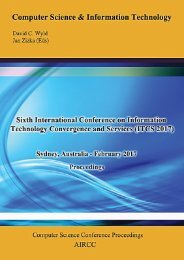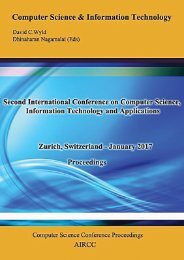CoSIT 2017
Fourth International Conference on Computer Science and Information Technology ( CoSIT 2017 ), Geneva, Switzerland - March 2017
Fourth International Conference on Computer Science and Information Technology ( CoSIT 2017 ), Geneva, Switzerland - March 2017
You also want an ePaper? Increase the reach of your titles
YUMPU automatically turns print PDFs into web optimized ePapers that Google loves.
Computer Science & Information Technology (CS & IT) 149<br />
submissions by companies and others who are required by law to file forms with the U.S.<br />
Securities and Exchange Commission” [25].<br />
Originally the EDGAR system was developed by the SEC as a pilot system for electronic<br />
disclosure in 1983. In order to test and evaluate EDGAR´s performance the SEC requested<br />
electronic filings in 1994 after completing the phase-in of a mandated test group in December<br />
1993 (the phase-in began on April 26, 1993) [26] [11] [27]. As of May 6, 1996 the SEC obligated<br />
all public domestic U.S. companies (issuers) to file submissions electronically through the<br />
EDGAR system [28] [11] [27] [1] except for certain filings made in paper because of a hardship<br />
exemption under Regulation S-T [29] [25]. Filing for foreign private issuers (companies<br />
organized outside of the U.S.) and foreign governments via EDGAR [26] became mandatory on<br />
May 14, 2002 [30]. The Securities Exchange Act of 1934 (Securities Exchange Act 1934, Section<br />
13(a), (b), Section 15(d)) empowers the SEC to require (periodic) reporting of information from<br />
publicly held companies [24]. In general, all public domestic companies with assets exceeding<br />
$10 million and at least 500 shareholders become subject to Exchange Act reporting requirements<br />
(Securities Exchange Act 1934, Section 12(g)) alongside certain individuals [10]. Among other<br />
disclosures, corporations with publicly traded securities are required (Securities Exchange Act<br />
1934, Section 13(a), (b), Section 15(d)) to file annual and quarterly reports (Form 10-K, Form 10-<br />
Q) as well as current reports (Form 8-K) on an ongoing basis with the SEC and its EDGAR<br />
system [24]. Since by law these public corporate disclosures have to be accurate (Securities<br />
Exchange Act 1934, Section 13(i)) and represent a company´s operations, they themselves<br />
represent a treasure trove of valuable information for investors and researchers [10] [18].<br />
2.1. Underlying data in SEC´s EDGAR database<br />
In order to understand the amount and variety of corporate information (e.g. financial statements)<br />
distributed by the SEC, I retrieve and analyze all form index files since the implementation of the<br />
EDGAR system in 1993. The SEC EDGAR form index files list all publicly available disclosures<br />
made through the system in a certain quarter and sort the submissions by their particular filing<br />
form type. Table 1 reports the total number of submissions that have been made with the EDGAR<br />
system for each quarter and year since the introduction of the EDGAR database.<br />
A tremendous amount of publicly available disclosures was filed with the SEC between 1993 and<br />
2016. In total 15,998,058 filings were submitted to the EDGAR system in order to be publicly<br />
distributed. On average 31.48 percent (5,035,554) of these filings became available in the first,<br />
25.74 percent (4,117,631) in the second, 20.97 percent (3,355,412) in the third and 21.81 percent<br />
(3,489,461) in the last quarter of each year since 1993. Most noticeable is the overall increase in<br />
total submissions through the EDGAR system reaching its peak in 2007 with more than 1.1<br />
million disclosures for that particular year. By analyzing the index files more precisely, investors<br />
and researchers can gain an insight into the specific type of information the SEC is making<br />
publicly available through its EDGAR system [5]. Table 2 describes the most common filing<br />
(form) types filed with the EDGAR system.





